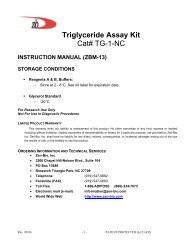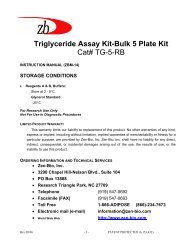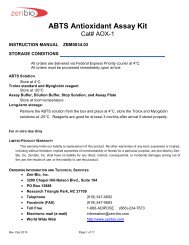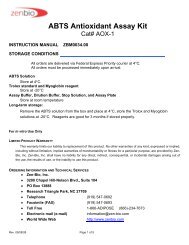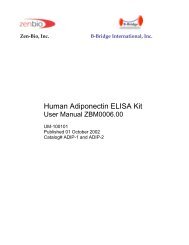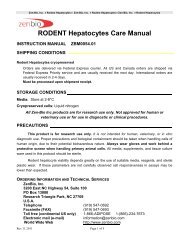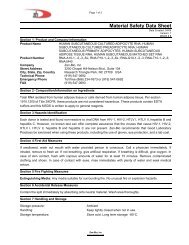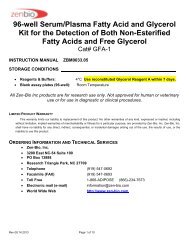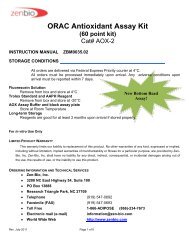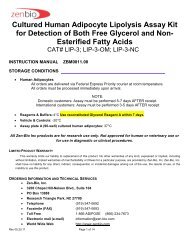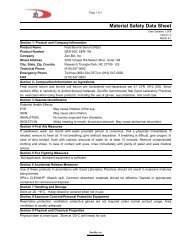96-well Serum/Plasma Glycerol Kit Free Glycerol ... - Zen-Bio Inc.
96-well Serum/Plasma Glycerol Kit Free Glycerol ... - Zen-Bio Inc.
96-well Serum/Plasma Glycerol Kit Free Glycerol ... - Zen-Bio Inc.
You also want an ePaper? Increase the reach of your titles
YUMPU automatically turns print PDFs into web optimized ePapers that Google loves.
<strong>96</strong>-<strong>well</strong> <strong>Serum</strong>/<strong>Plasma</strong> <strong>Glycerol</strong> <strong>Kit</strong><br />
<strong>Free</strong> <strong>Glycerol</strong> Detection<br />
Cat# SGA-1<br />
INSTRUCTION MANUAL<br />
ZBM0043.00<br />
STORAGE CONDITIONS<br />
Reagents & Buffers: 4°C<br />
<strong>Glycerol</strong> Standard: -20°C<br />
Blank assay plates (<strong>96</strong>-<strong>well</strong>): Room Temperature<br />
For in vitro Use Only<br />
LIMITED PRODUCT WARRANTY<br />
This warranty limits our liability to replacement of this product. No other warranties of any kind, expressed or implied, including<br />
without limitation, implied warranties of merchantability or fitness for a particular purpose, are provided by <strong>Zen</strong>-<strong>Bio</strong>, <strong>Inc</strong>. <strong>Zen</strong>-<strong>Bio</strong>, <strong>Inc</strong>.<br />
shall have no liability for any direct, indirect, consequential, or incidental damages arising out of the use, the results of use, or the<br />
inability to use this product.<br />
ORDERING INFORMATION AND TECHNICAL SERVICES<br />
<strong>Zen</strong>-<strong>Bio</strong>, <strong>Inc</strong>.<br />
3200 Chapel Hill-Nelson Blvd., Suite 104<br />
PO Box 13888<br />
Research Triangle Park, NC 27709<br />
Telephone (919) 547-0692<br />
Facsimile (FAX) (919) 547-0693<br />
Toll <strong>Free</strong> 1-866-ADIPOSE (866)-234-7673<br />
Electronic mail (e-mail)<br />
World Wide Web<br />
information@zen-bio.com<br />
http://www.zen-bio.com<br />
Rev 8/15/2008 Page 1 of 6
INTRODUCTION<br />
This kit is designed to accurately determine the amount of glycerol present in blood serum or plasma of<br />
humans, mice, rats, and other animals in a <strong>96</strong>-<strong>well</strong> format for increased throughput analysis. Blood can be<br />
collected in plain evacuated tubes or in the presence of common anti-coagulants: sodium citrate, ammonium<br />
oxalate and EDTA. NOTE: Heparin or Heparinized tubes should not be used because this will generate<br />
inaccurate readings. <strong>Serum</strong> should be separated from clotted blood by centrifugation as soon as possible and<br />
may be stored frozen (-20°C) prior to analysis.<br />
PRINCIPLE OF THE ASSAY<br />
Detection of <strong>Free</strong> <strong>Glycerol</strong><br />
<strong>Glycerol</strong> present in sample is phosphorylated by adenosine triphosphate (ATP) forming glycerol-1-<br />
phosphate (G-1-P) and adenosine-5’-diphosphate (ADP) in the reaction catalyzed by glycerol kinase. G-1-P is<br />
then oxidized by glycerol phosphate oxidase to dihydroxyacetone phosphate (DAP) and hydrogen peroxide<br />
(H 2 O 2 ). A quinoneimine dye is produced by the peroxidase catalyzed coupling of 4-aminoantipyrine (4-AAP) and<br />
sodium N-ethytl-N-(3-sulfopropyl)m-anisidine (ESPA) with H 2 O 2 , which shows an absorbance maximum at<br />
540nm. The increase in absorbance at 540nm is directly proportional to glycerol concentration of the sample.<br />
GLYCEROL + ATP<br />
G-1-P + ADP<br />
G-1-P + O 2 DAP + H 2 O 2<br />
H 2 O 2 +4-AAP + ESPA<br />
Quinoneimine dye + H 2 O<br />
ITEMS INCLUDED IN THE KIT<br />
ITEM DESCRIPTION Cap UNIT QTY STORAGE<br />
Color<br />
Assay Plate, Plate A <strong>96</strong>-<strong>well</strong> assay plate, blank --- PLATE 2 -----<br />
Dilution Buffer 12 ml --- BOTTLE 1 4°C<br />
<strong>Glycerol</strong> Reagent A Reconstitute with 11.0 ml deionized water prior to use. --- BOTTLE 1 4°C<br />
Tray For multi-channel pipetters, clear polyvinyl CLEAR EACH 2 -----<br />
<strong>Glycerol</strong> standard <strong>Glycerol</strong> @ 1mM [Dilute with 200 l Dilution Buffer to ORANGE 50 l / 1 -20°C<br />
make the 200 M glycerol standard; see page 5 for<br />
recommended dilution scheme]<br />
Other equipment/reagents required but not provided with the kit:<br />
Multi-channel Pipet , single channel pipet and pipet tips<br />
Plate reader with a filter of 540 nm<br />
<strong>Inc</strong>ubator at 37 o C<br />
Large gauge needle<br />
Tubes for diluting standards<br />
VIAL<br />
Rev 8/15/2008 Page 2 of 6
ASSAY PROCEDURE<br />
1. Prepare the glycerol standards as follows:<br />
Briefly spin down the contents of the glycerol standard tube before reconstitution. Pipette 200 l of<br />
Dilution Buffer into the 1 mM glycerol standard tube provided and mix <strong>well</strong> by vortexing. This<br />
produces a diluted stock glycerol standard of 200 M. Pipette 125 l of dilution buffer into 6 tubes<br />
(not provided). Using the newly diluted stock glycerol solution, prepare a dilution series as<br />
depicted below. Mix each new dilution thoroughly before proceeding to the next. The 200 M<br />
stock dilution serves as the highest standard, and the dilution buffer serves as the zero standard.<br />
200 l 125 l 125 l 125 l 125 l 125 l 125 l<br />
Dilution<br />
Buffer<br />
Std<br />
200<br />
M<br />
100<br />
M<br />
50<br />
M<br />
25<br />
M<br />
12.5<br />
M<br />
6.25<br />
M<br />
3.125<br />
M<br />
2. Also at this time prepare the <strong>Glycerol</strong> Reagent A by adding 11.0 ml room temperature deionized water per<br />
bottle and gently invert. DO NOT VORTEX! Use a pipet to ensure that the powder is completely<br />
dissolved. Store at room temperature. If using a Reagent A solution previously prepared and stored at 2-<br />
8 C, also bring to room temperature. Make sure there is enough Reagent A from one solution to treat all<br />
the points in the assay. It may be necessary to combine solutions. Store in a light protected bottle.<br />
Reconstituted <strong>Glycerol</strong> Reagent A is stable for 60 days refrigerated (2-8 C); store any remaining solution<br />
refrigerated (2-8 C).<br />
3. Add 20 l (or 10 - 25 l) of serum or plasma to a <strong>well</strong> of a blank plate for assessment of free glycerol. Add<br />
30 l of dilution buffer to each <strong>well</strong> to total 50 l including serum or plasma sample. THIS RESULTS IN A<br />
2.5x DILUTION OF YOUR SAMPLE (20 l in 50 l). Add 50 l of each standard to empty <strong>well</strong>s (use<br />
another plate, if necessary).<br />
4. Add the reconstituted <strong>Glycerol</strong> Reagent A solution to one of the disposable trays provided in the kit. Add<br />
50 l of Reagent A to each <strong>well</strong> of the glycerol plate. Gently, pipet up and down once to mix. Pop the<br />
bubbles using a large gauge needle or a clean pipet tip. The plate is then incubated at 25 o C (room<br />
temperature) for 15 minutes.<br />
5. The optical density of each <strong>well</strong> is then measured at 540 nm.<br />
Rev 8/15/2008 Page 3 of 6
OD<br />
GLYCEROL STANDARD CURVE<br />
Generate standard curve: see example below<br />
[DO NOT use this standard curve to generate your data. This is an example.]<br />
Subtract the OD value of the 0 M standard from all OD values including the standard curve.<br />
Zero<br />
(blank) = .040<br />
M<br />
<strong>Glycerol</strong> OD<br />
OD -<br />
blank<br />
3.125 0.054 0.014<br />
6.25 0.066 0.026<br />
12.5 0.082 0.042<br />
25 0.138 0.098<br />
50 0.214 0.174<br />
100 0.402 0.362<br />
200 0.711 0.671<br />
slope = 0.0034<br />
intercept= 0.0075<br />
r 2 = 0.9985<br />
0.8<br />
0.7<br />
0.6<br />
0.5<br />
0.4<br />
0.3<br />
0.2<br />
0.1<br />
0.0<br />
Standard Curve<br />
y = 0.0034x + 0.0075<br />
R 2 = 0.9985<br />
0 50 100 150 200 250<br />
<strong>Glycerol</strong> in uM<br />
y = observed O.D. minus the blank<br />
x = concentration of glycerol in M<br />
To calculate x for each y, (i.e. to change the observed O.D. into glycerol concentration) use the following<br />
equation:<br />
y=(slope) times (x) plus intercept<br />
y=mx+b so x=(y-b)/m<br />
x=(y – 0.0075)/0.003 where 0.003= slope of the line and 0.0075= y intercept. Be careful to enter the proper sign<br />
for the y intercept value as it may be a negative number.<br />
Any OD values greater than the highest standard (200 M) should be suspect. The compound should be reassayed<br />
using a lower dose of the compound at treatment OR a dilute solution of the condition medium at the<br />
time of the assay.<br />
The R 2 value should be equal or greater than 0.98 for the standard curve to be valid. Any R 2 values below<br />
0.98, must have the standard curve run again.<br />
Data are expressed as M glycerol.<br />
REMEMBER TO ACCOUNT FOR THE DILUTION FACTOR IN STEP 3.<br />
Rev 8/15/2008 Page 4 of 6
A<br />
B<br />
C<br />
D<br />
E<br />
F<br />
G<br />
H<br />
1 2 3 4 5 6 7 8 9 10 11 12<br />
APPENDIX A: PLATE LAYOUT<br />
Rev 8/15/2008 Page 5 of 6
APPENDIX B: PROCEDURE FLOWCHART<br />
<strong>Glycerol</strong> Detection<br />
Add 20 l/<strong>well</strong> test sample and 30 l/<strong>well</strong> dilution<br />
buffer to one of the blank assay plates provided.<br />
Add 50 l/<strong>well</strong> diluted standard curve to empty <strong>well</strong>s.<br />
Sample<br />
20 l<br />
Plate A<br />
OOOOOOOOOOOO<br />
OOOOOOOOOOOO<br />
OOOOOOOOOOOO<br />
OOOOOOOOOOOO<br />
OOOOOOOOOOOO<br />
Reconstitute <strong>Glycerol</strong> Reagent A.<br />
Add 50 l/<strong>well</strong>.<br />
OOOOOOOOOOOO<br />
OOOOOOOOOOOO<br />
OOOOOOOOOOOO<br />
OOOOOOOOOOOO<br />
OOOOOOOOOOOO<br />
50 l/<strong>well</strong><br />
<strong>Glycerol</strong><br />
Reagent A<br />
OOO<br />
OOO<br />
OOO<br />
OOO<br />
OOO<br />
Plate B<br />
<strong>Inc</strong>ubate 15 minutes @ room temperature.<br />
Measure the optical density of each <strong>well</strong><br />
at 540 nm using a spectrophotometer<br />
plate reader.<br />
Reminder: Sample was diluted in Step 3<br />
Rev 8/15/2008 Page 6 of 6



